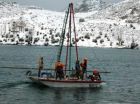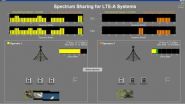(Press-News.org) Free-flowing cancer cells have been mapped with unprecedented accuracy in the bloodstream of patients with prostate, breast and pancreatic cancer, using a brand new approach, in an attempt to assess and control the disease as it spreads in real time through the body, and solve the problem of predicting response and resistance to therapies.
In comparison to a previous generation of systems, the researchers state their test showed a significantly greater number of high-definition circulating tumour cells (HD-CTCs), in a higher proportion of patients, by using a computing-intensive method that enables them to look at millions of normal cells and find the rare cancer cells among them.
Their results, published today, Friday 3 February 2012, in IOP Publishing's journal Physical Biology, could help reveal the mechanisms behind the spread of solid tumours from one organ or tissue to another – mechanisms that have, until now, remained a mystery.
Dr Jorge Nieva, an oncologist at Billings Clinic leading the study, said: "This technology will allow scientists to move away from mouse and cell culture systems and speed the delivery of cures for cancer in people. This is the technology we have been waiting for to solve the problem of resistance to chemotherapy drugs."
Senior technology author of the study, Professor Peter Kuhn, said: "In the future, our fluid biopsy can effectively become the companion to the patient for life. If we can assess the disease in real time, we can make quantitative treatment decisions in real time. These decisions include predictive decisions about therapeutic response, diagnostic decisions and prognostic decisions about outcome."
The researchers, based at the Scripps Physics Oncology Center in La Jolla, California, were able to find five or more CTCs in each milliliter of blood in 80% of the 20 patients they tested with prostate cancer; 70% in the 30 patients with breast cancer; and 50% in the 18 patients with pancreatic cancer.
The authors also report that their test showed significantly better results when compared with the commercial test, CellSearch®, which uses a slightly less accurate approach which effectively reduces the sample from approximately 50 million cells to just 5,000 before conducting fluorescent imaging, meaning important cells you wish to study could be lost.
In 7.5 mL of blood, the CellSearch® test found two or more CTCs in 5 out of the 15 patients tested whereas the new test found two or more CTCs in a single milliliter of blood in 14 out of the 15 patients tested.
The dyes used in this new approach contain antibodies that target, and then attach to, specific proteins that are expressed by the CTCs. Once attached, they fluoresce and allow the researchers to observe them. The result is a set of high resolution digital images that retain the intricate details of the cells and allow the researchers to effectively analyse them in the laboratory. Also striking is the quality of the images.
"The high definition method gives a detailed portrait of these elusive cells that are caught in the act of spreading around the body. It's unprecedented – we've never been able to see them routinely and in high definition like this before," says diagnostic pathologist Kelly Bethel, MD, the senior clinical investigator on Kuhn's team.
"The science behind this approach, and the ability to obtain more detailed information about CTCs in a timely fashion, opens up opportunities to address some of the outstanding problems in cancer, such as drug-resistance. This is an example that bringing a physical sciences approach to a medical need has potential for profound consequences to greatly benefit cancer patients," said Dr Larry Nagahara of the National Cancer Institute.
### This paper is one of five to be published today in the journal Physical Biology by the research team at the Scripps Physics Oncology Center (http://4db.us) part of the signature initiative of the National Cancer Institute in Physical Sciences in Oncology (http://physics.cancer.gov). Participating clinics included the Billings Clinic, UCSD Moores Cancer Centre, USC and UCSF.
Notes to Editors
Contact
1. For further information, a full draft of the journal paper or contact with one of the researchers, contact IOP Publishing Press Officer,
Michael Bishop:
Tel: 0117-930-1032
E-mail: Michael.Bishop@iop.org
Fluid biopsy in patients with metastatic prostate, pancreatic and breast cancers
2. The published version of the paper "Fluid biopsy in patients with metastatic prostate, pancreatic and breast cancers" D Marrinucci et al 2012 Phys. Biol. 9 016003 will be freely available online from 3 February 2012. It will be available at http://iopscience.iop.org/1478-3975/9/1/016003
Physical Biology
3. Physical Biology publishes research on the quantitative characterization and understanding of biological systems at different levels of complexity.
IOP Publishing
4. IOP Publishing provides publications through which leading-edge scientific research is distributed worldwide. IOP Publishing is central to the Institute of Physics (IOP), a not-for-profit society. Any financial surplus earned by IOP Publishing goes to support science through the activities of IOP. Beyond our traditional journals programme, we make high-value scientific information easily accessible through an ever-evolving portfolio of community websites, magazines, conference proceedings and a multitude of electronic services. Focused on making the most of new technologies, we're continually improving our electronic interfaces to make it easier for researchers to find exactly what they need, when they need it, in the format that suits them best. Go to http://ioppublishing.org/
The Institute of Physics
5. The Institute of Physics is a leading scientific society promoting physics and bringing physicists together for the benefit of all.
It has a worldwide membership of around 40 000 comprising physicists from all sectors, as well as those with an interest in physics. It works to advance physics research, application and education; and engages with policy makers and the public to develop awareness and understanding of physics. Its publishing company, IOP Publishing, is a world leader in professional scientific communications. Go to http://www.iop.org
New technology to tackle treatment-resistant cancers
2012-02-06
ELSE PRESS RELEASES FROM THIS DATE:
NYU Courant researchers weigh methods to more accurately measure genome sequencing
2012-02-06
Lost in the euphoria of the 2003 announcement that the human genome had been sequenced was a fundamental question: how can we be sure that an individual's genome has been read correctly?
While the first full, individual genome was sequenced a decade ago, given the vast genetic variation across the world's seven billion people, not to mention the differences in makeup even among close relatives, the question of accurate sequencing for individuals has continued to vex researchers.
With companies now projecting they can sequence a genome for a $1,000, down from $25,000 ...
Parasites or not? Transposable elements in fruit flies
2012-02-06
Nearly all organisms contain pieces of DNA that do not really belong to them. These "transposable elements", so called because they are capable of moving around within and between genomes, generally represent a drain on the host's resources and in certain cases may lead directly to disease, e.g. when they insert themselves within an essential host gene. The factors that govern the spread of transposable elements within a population are broadly understood but many of the finer points remain unclear. New work at the University of Veterinary Medicine, Vienna (Vetmeduni ...
Sediments from the Enol lake reveal more than 13,500 years of environmental history
2012-02-06
A team of Spanish researchers have used different geological samples, extracted from the Enol lake in Asturias, to show that the Holocene, a period that started 11,600 years ago, did not have a climate as stable as was believed.
The Holocene period, which includes the last 11,600 years of our history, has always been described as a stable period in terms of climatic conditions, especially when compared to the abrupt changes that occurred in the last ice age, which ended around 10,000 years ago, giving way to the Holocene.
A study carried out by researchers from the Pyrenean ...
Jointly utilizing LTE networks
2012-02-06
Smartphones and tablets are some of the big sellers of the past year. Mobile Internet usage has increased rapidly with the sales success: according to a study of the industry association VATM, in 2011 the average data volume per mobile Internet user increased by 82 percent in Germany. In contrast to its predecessor UMTS, with the new LTE mobile radio standard, the clearly higher data rates and the shorter signal transmission times, providers want to cover the expected traffic. That is why the expansion of the LTE network is being pursued aggressively. Providers are setting ...
Making sense of addiction terminology
2012-02-06
London, UK – A new editorial released this week offers clarity and structure on confusing drug and alcohol addiction terminology for prescribers, users and regulators. "Through a glass darkly: can we improve clarity about mechanism and aims of medications in drug and alcohol treatments?" is published in the Journal of Psychopharmacology, the official journal of the British Association for Psychopharmacology, published by SAGE.
David Nutt and Anne Lingford-Hughes of Imperial College London's Neuropsychopharmacology Unit together with Jonathan Chick from Queen Margaret ...
Collective action
2012-02-06
If you wanted to draw your family tree, you could start by searching for people who share your surname. Cells, of course, don't have surnames, but scientists at the European Molecular Biology Laboratory (EMBL) in Heidelberg, Germany, have found that genetic switches called enhancers, and the molecules that activate those switches – transcription factors – can be used in a similar way, as clues to a cell's developmental history. The study, published today in Cell, also unveils a new model for how enhancers function.
Looking at fruit fly embryos, Guillaume Junion and Mikhail ...
Judder-free videos on the smartphone
2012-02-06
The journey for the family holiday can be a long one. To avoid the incessant "Are we there yet?", stressed parents gladly hand their smartphones to the back seat – so the kids can watch videos or movies on the internet. While modern technology provides for entertainment, it occasionally reaches its limits and then the whining returns: The movies sometimes judder, or are completely interrupted. The cause may be twofold: If the user is standing at the basin of a valley and has poor reception, the data stream transmission rate is inadequate and the cellphone cannot download ...
Surface of Mars an unlikely place for life after 600 million year drought, say scientists
2012-02-06
Mars may have been arid for more than 600 million years, making it too hostile for any life to survive on the planet's surface, according to researchers who have been carrying out the painstaking task of analysing individual particles of Martian soil. Dr Tom Pike, from Imperial College London, will discuss the team's analysis at a European Space Agency (ESA) meeting on 7 February 2012.
The researchers have spent three years analysing data on Martian soil that was collected during the 2008 NASA Phoenix mission to Mars. Phoenix touched down in the northern arctic region ...
Global extinction: Gradual doom is just as bad as abrupt
2012-02-06
A painstakingly detailed investigation shows that mass extinctions need not be sudden events. The deadliest mass extinction of all took a long time to kill 90 percent of Earth's marine life, and it killed in stages, according to a newly published report.
Thomas J. Algeo, professor of geology at the University of Cincinnati, worked with 13 co-authors to produce a high-resolution look at the geology of a Permian-Triassic boundary section on Ellesmere Island in the Canadian Arctic. Their analysis, published Feb. 3 in the Geological Society of America Bulletin, provides strong ...
Soy isoflavone supplements did not provide breast cancer protections
2012-02-06
PHILADELPHIA -- Soy isoflavone supplements did not decrease breast cancer cell proliferation in a randomized clinical trial, according to a study published in Cancer Prevention Research, a journal of the American Association for Cancer Research.
Lead researcher Seema A. Khan, M.D., professor of surgery at the Robert H. Lurie Comprehensive Cancer Center of Northwestern University, said the results of this study are consistent with the findings of previous studies that were designed to test cancer prevention benefits of dietary supplements.
"Simply put, supplements are ...



